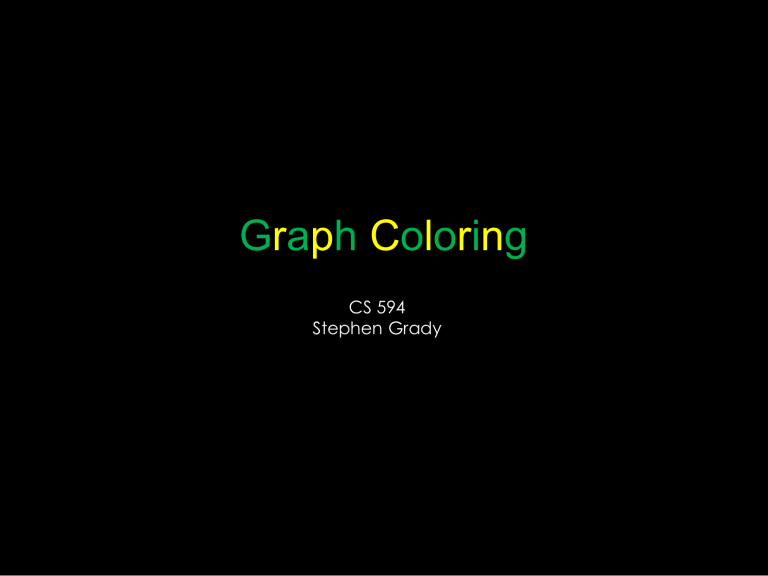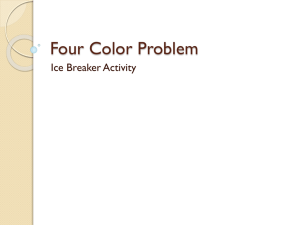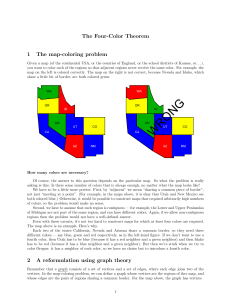G a h o

G r a p h C o l o r i n g
CS 594
Stephen Grady
Overview
-
Terminology
-History
4 Color Theorem
Kempe’s flawed proof
-Simple Bounds on chromatic number
-Coloring on Digraphs
-Applications
Terminology
-Color: Any labeling assigned to an element of a graph.
-Proper coloring: No color may be adjacent to itself.
Terminology
-Chromatic number ( χ(G)): Minimum colors needed to properly color graph.
-Chromatic Equivalency: Two graphs are chromatically equivalent if they have the same χ(G)
Chromatic Polynomial
-The possible number of ways to color a graph using k colors.
Example K
3+1 colors can be colored 12 different ways with 3
Types of Coloring
-Vertex-Vertices are labeled
-Edge-Edges are labeled
-Total-Both vertices and edges are labeled
-Many more...
Vertex coloring
-Coloring most concerned with
-Other colorings can be transformed to vertex coloring
Edge: color vertices of line graph
Planer: color vertices of dual
History
-First studied as a map coloring problem.
-What is the minimum number of colors needed to color a map. Or stated another way, what is the minimum number of colors needed to color a planar graph?
4 Color Theorem
-Francis Guthrie first noticed he could color the map of the counties of England using only 4 colors.
-Naturally the question of if this holds true for all maps (planar graphs) arose.
4 Color Theorem
-The question was passed along in 1852
Guthrie's brother->Augustus de Morgan->William
Hamilton
-Eventually it was brought up to the London
Mathematical Society in 1879
-That same year Alfred Kempe published a paper claiming to contain a proof that 4 colors suffice.
Sir Alfred Kempe
-1849-1922
-Trinity College, Cambridge
-22 nd wrangler
-1877: Flawed “straight line linkage” proof, though ideas basis of proof in 2002
-1879: Flawed 4 color theorem proof though ideas basis of proof in 1976
Percy John Heawood
-1861-1955
-Exeter College, Oxford
-Much of life dedicated to
4 color theorem
-1890:Disproved Kempe's
4 color theorem proof
-1890:Established 5 color theorem based on Kempe's work
Kemp's Flawed 4 Color Theorem
-Kempe's proof rested on the properties of what are known as Kempe chains.
-A Kempe chain is a bicolored path between any two non-adjacent vertices.
Kempe's Argument
-Assume Δ(G) ≤5 (There is a proof but I’ll leave that to whomever covers planarity)
-Consider the smallest planar graph G in terms of
|V| that requires 5 colors to color properly.
-Delete any vertex v in G creating G'. Since G' is smaller than G, G' is 4 colorable.
-Color all vertices in G' using 4 colors.
Kempe's Argument
-Now add back v to G' recreating G.
-There are three cases to consider when deciding how to color v with one of the four colors used.
deg (v) =1,2 or 3 deg (v)=4 deg (v)=5
Case 1
v has degree 1,2 or 3.
-Since the neighbors of v only take up to 3 of the possible colors in this case coloring v is trivial.
Case 2
-v has degree 4 and neighbors a, b, c and d .
-If the neighbors of v do not use all 4 colors, then coloring v is trivial.
-If all 4 colors are used by the neighbors of v then choose any two neighbors a ,c of v and consider the subgraph H of G induced by the colors of a and c .
-This creates two possibilities
Case 2 Subcase i
-There does not exist a Kempe chain between a and c
-If this is the case then consider the subgraph J of
H induced by taking all vertices that have a path to a .
-Perform a color swap on J and now a and c share the same color and v may be colored with the remaining color.
Case 2 Subcase ii
-There does exist a Kempe chain between a and c .
-Now consider the subgraph H' of G induced by the colors of b and d.
-Because G is planar there cannot exist a Kempe chain from b to d.
-Simply perform a color swap on b as in subcase i.
Case 3
-v has degree 5 with neighbors a,b,c,d and e .
-Add edges to all neighbors of v while staying planar
-Assume all 4 colors are used by neighbors of v .
-Just like in case 2 there exist 2 subcases.
Case 3 Subcase i
-Consider three neighbors b, e and d.
-As in case 2 consider the subgraph H of G induced by the colors of b and e .
-If no Kempe chain, do a color swap.
-If Kempe chain, repeat for b and d.
Case 3 Subcase ii
-Both b to d and b to e have a kempe chain.
-Consider the subgraph H' of G induced by colors on a and d. As with case 2 because G is planar there cannot exist a Kempe chain from a to d so a color swap can be performed on a.
Repeat for c and e .
So, why is it flawed?
Haewood's Counter
What if the Kempe chain's b to d and b to e cross?
4 Color Theorem
-Finally proven in 1976 by Kenneth Appel and
Wolfgang Haken at University of Illinois.
-First proof using a computer as an aid.
4 Color Theorem
-Used the idea of an unavoidable set of reducible configurations
-Had to check 1,936 graphs to prove minimum counterexample to 4 color theorem could not exist.
Complexity
-Decision: Given a graph G can it be colored with k colors? NP-Complete
-Optimization: What is χ(G)? NP-Hard
Bounds on χ(G)
-Brooke's Theorem
-Clique number
Brooke's Theorem
χ(G) ≤ Δ(G)
Except for Kn and C2n+1
χ(G) ≤ Δ(G)+1
Clique Number
χ(G) >= ω(G)
-A clique of size Kn must be colored with n colors.
Mycielski's Theorem
-There exists a triangle free graph with arbitrarily high χ(G).
-Generalized with Mycielski graphs.
Coloring on Digraphs
-Gallai-Roy Theorem
χ(G) =L+1 where L is the longest path in its shortest orientation.
Applications
-Applications are generally those that must satisfy some constraint
Scheduling
Register allocation
Determining if graph is bipartite
Sudoku
Scheduling
Used to find minimum number of time slots needed with no time conflicts.
Each time slot represented by a color.
Each edge represents time conflict
Register Allocation
In an attempt to optimize code, compilers will allocate multiple variables to the same register.
However, multiple variables allocated to the same register cannot be called at the same time.
Naturally this becomes a coloring problem.
Register Allocation
Determine if Graph is Bipartite
Bipartite Graphs always have χ(G)=2
Can check if graph is 2 colorable in linear time
Sudoku
Sudoku Graph Transformation
Coloring a Sudoku Graph
Sudoku
Why study Sudoku
Methods for solving Sudoku can be generalized to solve problems like protein folding.
Open Problems
Erdos-Faber-Lovasz Conjecture
Reed’s upper bound
Erdos-Faber-Lovasz Conjecture
Can n kn graphs each sharing only one vertex be colored with n colors.
Reed’s Upper Bound
χ(G) ≤ (1+Δ(G)+ω(G))/2
Homework
-Prove that for any planar graph 5 colors suffice
(Assume Δ(G) ≤5 )
-Which two of these graphs are chromatically equivalent?
k
4,4
, P
7
, k
5
, Peterson graph
-How many ways can a k6 be colored using 7 colors?
Email: sgrady3@vols.utk.edu
References
1.
https://en.wikipedia.org/wiki/Graph_coloring
2.
https://en.wikipedia.org/wiki/Alfred_Kempe
3.
https://en.wikipedia.org/wiki/Percy_John_Heawood
4.
https://en.wikipedia.org/wiki/Wrangler_%28University_of_Ca mbridge%29
5.
https://en.wikipedia.org/wiki/Four_color_theorem
6.
https://en.wikipedia.org/wiki/Mycielskian
7.
https://en.wikipedia.org/wiki/Gallai%E2%80%93Hasse%E2%80
%93Roy%E2%80%93Vitaver_theorem
8.
http://www.math.illinois.edu/~dwest/openp/
9.
http://math.ucsb.edu/~padraic/ucsb_2014_15/math_honors
_f2014/math_honors_f2014_lecture4.pdf
10.
https://en.wikipedia.org/wiki/Sudoku
References
11. https://en.wikipedia.org/wiki/Bipartite_graph
12. http://www.math.rutgers.edu/~sk1233/courses/grap htheory-F11/planar.pdf
13.
http://www.skidmore.edu/~adean/MC3021309/Print
Slides/MC302_131203_P.pdf
14. Ercsey-Ravasz, M. and Z. Toroczkai (2012). "The Chaos
Within Sudoku." Scientific Reports 2: 725.



